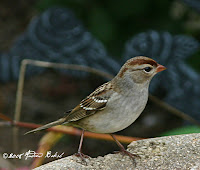The plan today, was to plant the remaining eight plants near the visitor’s center by the walkway to the rear of the building. I got to the center around 9:45 a.m. and started planting by 10:00 a.m. later on, I was joined by Nancy who helped me to water the plants once they were in the ground. Hopefully in May - July next year, I will have photos of blooming Virginia Roses to share.
As Nancy and I were heading back into the visitors center to put away the tools, we came across a birder who I noticed was trying to focus on some bird subject in the shrubs just to the left of the visitor center door. I stopped and began looking in the shrubs to find the subject, I did not have to look for too long as I saw a flash of yellow. Selecting a good spot as my marker, I swung up my Bi’s, which were around my neck and focused on the spot. Our subject turned out to be a Blue-headed Vireo. I hung around with the birder who introduced himself as Bob, and we had several good looks of the Vireo. We also saw a couple of White-throated Sparrows and Song Sparrows. In addition, during the time I was working, I had also heard and then noticed several Downy Woodpeckers, Yellow-rumped Warblers and also heard and saw a small flock of Pine Siskins flying overhead.
Here are some photos of the Vireo.

Blue-headed Vireo also known as the Solitary Vireo.

A closer look at the Blue-headed or Solitary Vireo.





